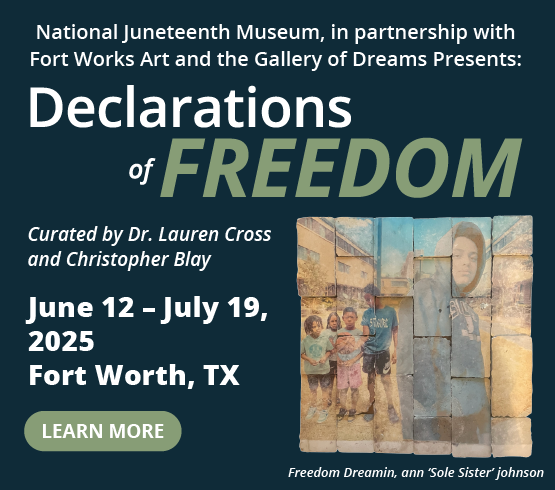Two of the central artworks in Mel Chin’s latest exhibition, Inescapable Histories, on view at The Gallery at UTA through March 30, are diptych paintings of a circular shape, resembling a solar body. Together they are titled, The Persistent of Emanation of Denial and Disease Waking the Enduring and Deepening Hue of Resistance, and in the artist’s description, “They have an eye-like form, responding to the Wide Awakes…an 1860s movement of [Union] soldiers offended by slavery.
A familiar adage says that history doesn’t repeat itself, but it does rhyme. In 2022, with online screeds about the “woke mob,” vigilantes escaping justice, and misinformation amped up to a fever pitch, the historical “rhyme” in Chin’s piece is practically limerick-like in its obviousness…if only history were that accessible. According to the artist, events of the past several years have “maybe also exposed the way America truly is. Deeply divided, resistant to science.” He says it has “confirmed the work that needs to be done.”
Because the intent of the work is “action to provide an option,” Mel Chin is devoted to ideas over medium. He is simultaneously dedicated to his craft and clear-eyed about its limitations. “I don’t know if art can do that much. Art should not be about power. It’s interesting that people talk about how much it costs, the value of it depends.” He says, “You have to put everything in a piece, that it can emanate all these thoughts.”A simple Google search of Chin’s work will reveal dozens of projects in locations near and far with collaborators and media of all kinds. “You can make art almost anywhere,” he says. “Being largely a conceptualist…there might not be a consistent marketplace.” His studio practice is one of “being reactive and being compelled.” Like some other artists over the last two years, the pandemic provided an unexpected, but not unwelcome, lull. “The pandemic was a luxury because I didn’t have to travel. It was a different kind of schedule, time to think about what might be important.”

1 ⁄5
Inescapable Histories, 1988
Hebron marble, wood, olive wood on plaster and drywall
, 81” (diameter)
Courtesy of the Artist

2 ⁄5
Aileen, 2015
Concrete, Hi-Standard .22 revolver
64” x 12” x 12”
Courtesy of the Artist

3 ⁄5
Elementary Object, 1993
Corsican briarwood, steel, plastic, concrete/vermiculite, excelsior packing material, flannel, paper tag, fuse cord, triple F blasting powder
3.5” x 12.5” x 10.25”
Courtesy of the Artist

4 ⁄5
Cross for the Unforgiven, 2018 (1/2)
AK-47 assault rifles (cut and welded)
54” x 54” x 3”
Courtesy of the Artist

5 ⁄5
Flag of America (with 25 stars on each side), 2021
Media: polyester
36” x 60” unframed
Courtesy of the Artist
“The world is full of upsetting things,” Chin muses. The past several years have given us “a very honest approximation of where we are,” he says, refusing us “this delusion of symbols.” Prominently featured in the exhibition is Flag of America (with 25 stars on each side), a banner of red and white stripes with two polarized blue fields of stars in opposing corners. Chin is adamant that “systems that are inadequate to give us our full options,” and art is a way of thinking ourselves outside of those systems. Like a rasp delivered to a prisoner inside a frosted cake, it offers us some means of escape. It should, “provide us with options we didn’t know we had before.”
For his own part, Chin seems open to any option that might present itself. “I really don’t know what I’m going to do next. I put myself in a position of not knowing.” He says, “From my point of view, I’ve tried to adopt a state of becoming. I don’t think I should be done. It’s a mutational force.”
—CASEY GREGORY




